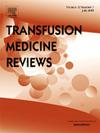与β-淀粉样蛋白相关的神经退行性疾病和神经血管疾病:输血医学的潜在影响
IF 2.5
2区 医学
Q2 HEMATOLOGY
引用次数: 0
摘要
脑淀粉样蛋白血管病变(CAA)是一种进行性脑血管和神经退行性疾病,由可溶性β-淀粉样蛋白异构体在大脑和小脑皮质以及脑膜的小血管壁上异常积聚引起。血管中的β-淀粉样蛋白沉积增加了脑内出血(ICH)的易感性。在临床上,高达一半的自发性脑叶 ICH 都是由 CAA 引起的,CAA 还可表现为凸面性蛛网膜下腔出血、一过性局灶性神经系统发作和进行性认知功能下降导致痴呆。大多数 CAA 是散发性的,发病率随着年龄的增长而增加,并经常与阿尔茨海默病(AD)并存。遗传和先天性病因很少见。CAA 和 AD 病例与使用尸体垂体激素有关,也有早年使用尸体硬脑膜移植物进行神经外科手术后出现晚年先天性 CAA 的病例。这些数据共同表明,β-淀粉样蛋白具有传递能力。最近的一项研究发现,在 100 多万名输血受者中,如果捐献者后来发生(i) 1 次 ICH 或 (ii) 1 次 ICH 事件和痴呆,那么他们将来发生 ICH 的风险就会升高。考虑到之前关于输血相关的人类变异型克雷兹费尔特-雅各布病的报道和绵羊的体内证据,再加上新出现的支持β-淀粉样蛋白的朊病毒样特性的数据,提出了 CAA 是否会通过输血传播的问题。这也将对筛查产生影响,尤其是在脑淀粉样变性血浆生物标志物不断涌现的时代。考虑到这一生物学上可信的问题所引发的公共卫生问题,今后需要对 CAA 的暴露和结果进行定义明确、时间确定的研究,以检查 CAA 是否可通过输血传播,如果是,发病的频率和时间如何。本文章由计算机程序翻译,如有差异,请以英文原文为准。
Beta-Amyloid Related Neurodegenerative and Neurovascular Diseases: Potential Implications for Transfusion Medicine
Cerebral amyloid angiopathy (CAA) is a progressive cerebrovascular and neurodegenerative disorder that is caused by the aberrant accumulation of soluble beta-amyloid isoforms in the small vessel walls of the cerebral and cerebellar cortices and the leptomeninges. Vascular beta-amyloid deposition increases vulnerability to intracerebral hemorrhage (ICH). Clinically, CAA can be the underlying cause of up to half of spontaneous lobar ICHs and can also present with convexity subarachnoid hemorrhage, transient focal neurologic episodes and progressive cognitive decline leading to dementia. The majority of CAA is sporadic, with increasing prevalence with age and often coexists with Alzheimer's Disease (AD). Genetic and iatrogenic etiologies are rare. Cases of CAA and AD have been linked to the use of cadaveric pituitary hormone and later life iatrogenic CAA has also been described following early-life neurosurgical procedures with cadaveric dura grafts. Together these data suggest a capacity of beta-amyloid transmissibility. A recent study found that in over 1 million transfusion recipients from donors who later developed (i) >1 ICH or (ii) one ICH event and dementia, had an elevated risk of developing future ICH. Considering prior reports of transfusion associated variant-Creutzfeldt Jakob Disease in humans and in vivo evidence in sheep, coupled with emerging data supporting beta-amyloid's prion-like properties, raises the question of whether CAA could be transmissible by blood transfusion. This would also have implications for screening, especially in an era of emerging plasma biomarkers of cerebral amyloidosis. Given the public health concerns raised by this biologically plausible question, there is a need for future studies with well-characterized definitions – and temporal ascertainment – of CAA exposure and outcomes to examine whether CAA is transfusion-transmissible, and, if so, with what frequency and timing of onset.
求助全文
通过发布文献求助,成功后即可免费获取论文全文。
去求助
来源期刊

Transfusion Medicine Reviews
医学-血液学
CiteScore
11.60
自引率
0.00%
发文量
40
审稿时长
21 days
期刊介绍:
Transfusion Medicine Reviews provides an international forum in English for the publication of scholarly work devoted to the various sub-disciplines that comprise Transfusion Medicine including hemostasis and thrombosis and cellular therapies. The scope of the journal encompasses basic science, practical aspects, laboratory developments, clinical indications, and adverse effects.
 求助内容:
求助内容: 应助结果提醒方式:
应助结果提醒方式:


